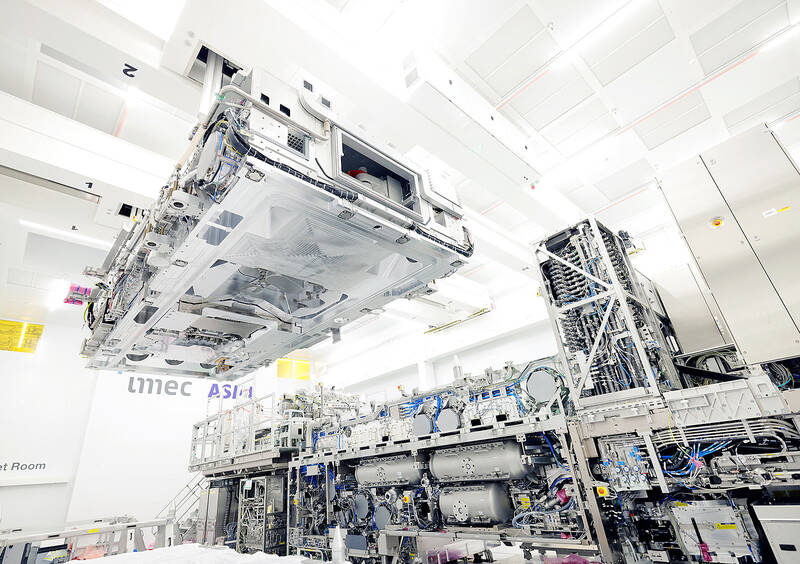ASML Holding NV is showing off its latest chipmaking machine, a 350 million euro (US$380 million) piece of equipment that weighs as much as two Airbus A320s.
Media outlets were given a tour on Friday of the system known as High-NA extreme ultraviolet. Intel Corp has already placed orders for the machine and got the first one shipped to a factory in Oregon in late December. The company plans to start making chips with it late next year.
The machine can print lines on semiconductors 8 nanometers thick, 1.7 times smaller than the previous generation. The thinner the lines, the more transistors you can fit on a chip. And the more transistors you can fit on a chip, the higher the processing speeds and memory.

Photo: Reuters
That is why, ASML executives said, the system will prove essential for artificial intelligence (AI), a technology that is notorious for the intensity of the processing it requires.
AI will need “massive amounts of computing power and data storage. I think without ASML, without our technology, that’s not going to happen,” company chief executive officer Peter Wennink said in an interview with Bloomberg last month. “It’s going to be a big driver for our business.”
ASML is the only company that produces equipment needed to make the most sophisticated semiconductors, and demand for its products is a bellwether for the industry’s health.
The Dutch company last quarter received record orders for its top-of-the-line extreme ultraviolet (EUV) lithography machines, showing optimism among the biggest customers for the technology, including Intel, Samsung Electronics Co and Taiwan Semiconductor Manufacturing Co (台積電).
Installation of the first 150,000-kilogram system required 250 crates, 250 engineers and six months to complete, ASML spokesperson Monique Mols said during the press tour of the company headquarters in Veldhoven.
The rise of generative AI over the past year, catalyzed by OpenAI’s ChatGPT launch late 2022, has boosted expectations for semiconductor companies across the board. The so-called low-NA EUV machines, which ASML has been selling since 2018, have a price tag of 170 million euros.

JITTERS: Nexperia has a 20 percent market share for chips powering simpler features such as window controls, and changing supply chains could take years European carmakers are looking into ways to scratch components made with parts from China, spooked by deepening geopolitical spats playing out through chipmaker Nexperia BV and Beijing’s export controls on rare earths. To protect operations from trade ructions, several automakers are pushing major suppliers to find permanent alternatives to Chinese semiconductors, people familiar with the matter said. The industry is considering broader changes to its supply chain to adapt to shifting geopolitics, Europe’s main suppliers lobby CLEPA head Matthias Zink said. “We had some indications already — questions like: ‘How can you supply me without this dependency on China?’” Zink, who also

The number of Taiwanese working in the US rose to a record high of 137,000 last year, driven largely by Taiwan Semiconductor Manufacturing Co’s (TSMC, 台積電) rapid overseas expansion, according to government data released yesterday. A total of 666,000 Taiwanese nationals were employed abroad last year, an increase of 45,000 from 2023 and the highest level since the COVID-19 pandemic, data from the Directorate-General of Budget, Accounting and Statistics (DGBAS) showed. Overseas employment had steadily increased between 2009 and 2019, peaking at 739,000, before plunging to 319,000 in 2021 amid US-China trade tensions, global supply chain shifts, reshoring by Taiwanese companies and

Taiwan Semiconductor Manufacturing Co (TSMC, 台積電) received about NT$147 billion (US$4.71 billion) in subsidies from the US, Japanese, German and Chinese governments over the past two years for its global expansion. Financial data compiled by the world’s largest contract chipmaker showed the company secured NT$4.77 billion in subsidies from the governments in the third quarter, bringing the total for the first three quarters of the year to about NT$71.9 billion. Along with the NT$75.16 billion in financial aid TSMC received last year, the chipmaker obtained NT$147 billion in subsidies in almost two years, the data showed. The subsidies received by its subsidiaries —

At least US$50 million for the freedom of an Emirati sheikh: That is the king’s ransom paid two weeks ago to militants linked to al-Qaeda who are pushing to topple the Malian government and impose Islamic law. Alongside a crippling fuel blockade, the Group for the Support of Islam and Muslims (JNIM) has made kidnapping wealthy foreigners for a ransom a pillar of its strategy of “economic jihad.” Its goal: Oust the junta, which has struggled to contain Mali’s decade-long insurgency since taking power following back-to-back coups in 2020 and 2021, by scaring away investors and paralyzing the west African country’s economy.